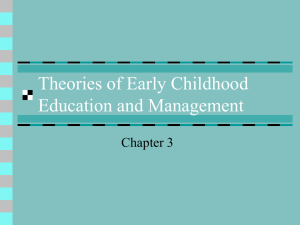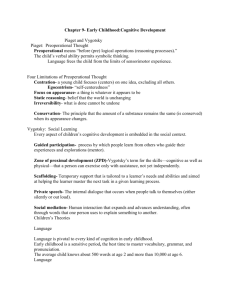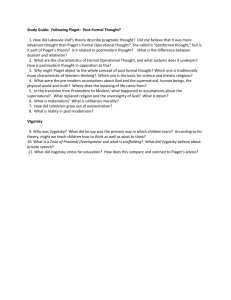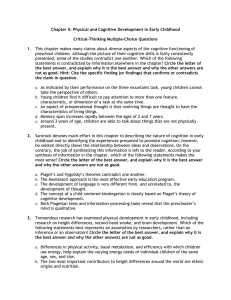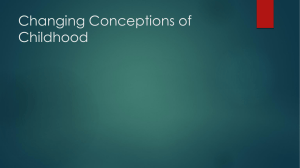Chapter 12: Middle Childhood: Cognitive Development Chapter Preview
advertisement
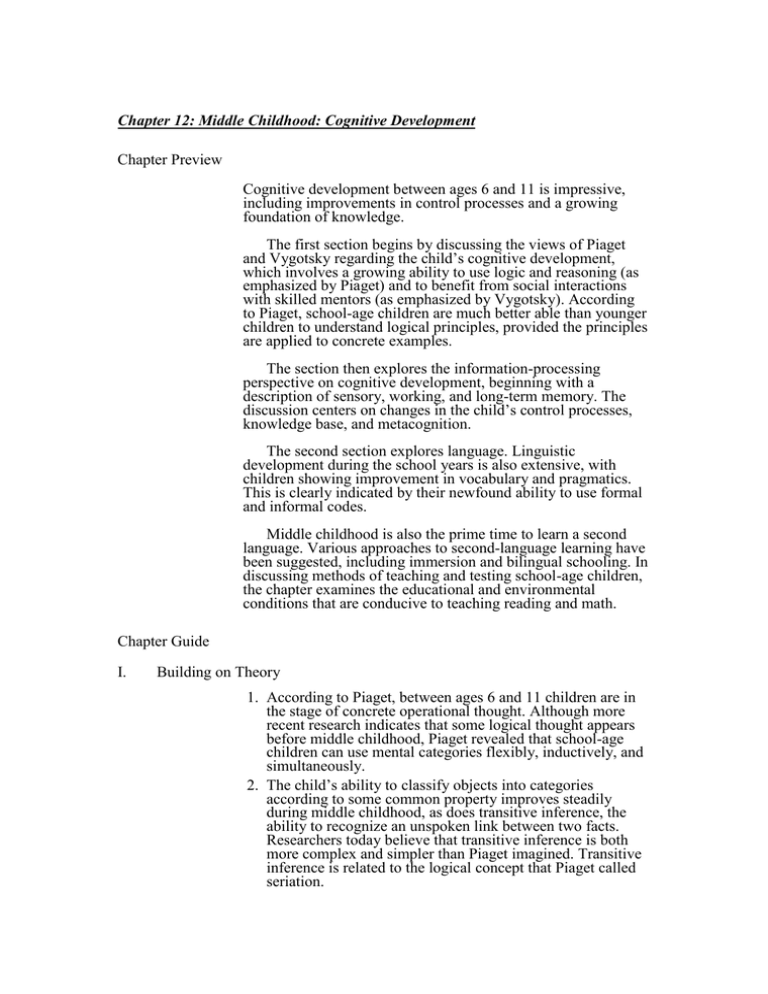
Chapter 12: Middle Childhood: Cognitive Development Chapter Preview Cognitive development between ages 6 and 11 is impressive, including improvements in control processes and a growing foundation of knowledge. The first section begins by discussing the views of Piaget and Vygotsky regarding the child’s cognitive development, which involves a growing ability to use logic and reasoning (as emphasized by Piaget) and to benefit from social interactions with skilled mentors (as emphasized by Vygotsky). According to Piaget, school-age children are much better able than younger children to understand logical principles, provided the principles are applied to concrete examples. The section then explores the information-processing perspective on cognitive development, beginning with a description of sensory, working, and long-term memory. The discussion centers on changes in the child’s control processes, knowledge base, and metacognition. The second section explores language. Linguistic development during the school years is also extensive, with children showing improvement in vocabulary and pragmatics. This is clearly indicated by their newfound ability to use formal and informal codes. Middle childhood is also the prime time to learn a second language. Various approaches to second-language learning have been suggested, including immersion and bilingual schooling. In discussing methods of teaching and testing school-age children, the chapter examines the educational and environmental conditions that are conducive to teaching reading and math. Chapter Guide I. Building on Theory 1. According to Piaget, between ages 6 and 11 children are in the stage of concrete operational thought. Although more recent research indicates that some logical thought appears before middle childhood, Piaget revealed that school-age children can use mental categories flexibly, inductively, and simultaneously. 2. The child’s ability to classify objects into categories according to some common property improves steadily during middle childhood, as does transitive inference, the ability to recognize an unspoken link between two facts. Researchers today believe that transitive inference is both more complex and simpler than Piaget imagined. Transitive inference is related to the logical concept that Piaget called seriation. 3. Vygotsky agreed with Piaget’s attention to the actual thinking of the child, but, unlike Piaget, regarded the guided participation, scaffolding, and mentoring of peers and teachers in the child’s zone of proximal development as crucial to cognitive development. Vygotsky’s emphasis on the sociocultural context contrasts with Piaget’s more maturational approach. 4. Research shows that culture affects the methods of learning, not just the content. 5. According to information-processing theory, incoming stimuli are held for a split second in the sensory memory (also called the sensory register), after which most of it is lost or discarded. Meaningful material is transferred into working memory (formerly called short-term memory), which handles mental activity that is current and conscious. Improvement in working memory occurs in two areas: the phonological loop, which stores sounds, and the visualspatial sketchpad, which stores sights. Long-term memory stores information for days, months, or years. 6. Storage of information and retrieval from long-term memory are crucial to development. Retrieval is easier for some memories than for others. 7. One reason children become better learners in middle childhood is that they have an expanded knowledge base, to which new knowledge becomes progressively easier to add. 8. The mechanisms that put memory, processing speed, and knowledge together are the control processes (the executive processes) of selective attention, metacognition, and emotional regulation. Control processes come from explicit instruction or discovery learning. 9. Schoolchildren are more advanced than preschoolers in metacognition, the ability to evaluate a cognitive task in order to determine how best to accomplish it, and then to monitor and adjust one’s performance on that task.. II. Language 1. During middle childhood, some children learn as many as 20 new words a day and apply complex grammar rules. The practical application of linguistic knowledge (pragmatics) also improves markedly at this time, as does the understanding of metaphors, jokes, and puns. 2. Children are increasingly able to switch from proper speech (formal code) to a more colloquial informal code with their peers. 3. Differences in how well children learn to speak, read, and write the language of the school may be partly genetic, but many emphasize the social context. 4. The connection between school achievement and socioeconomic status is revealed by the fact that children from low-income families are least likely to succeed in school. Their difficulty is generally in the area of language and includes having smaller vocabularies and using simpler grammar. 5. Three factors that contribute to greater school achievement are early exposure to language, the expectations of teachers and parents, and expectations from the child’s larger macrosystem. III. Teaching and Learning 1. Throughout history, children have been given new responsibility and instruction at about age 7. Traditionally, this occurred at home. Today, about 90 percent of children this age attend school. 2. The specifics of the educational curriculum vary by nation, by community, and by school subject. For example, they vary in when, how, and whether second-language and religious instruction occur. 3. Every culture creates its own hidden curriculum, the unofficial priorities that influence every aspect of school learning. The hidden curriculum is reflected in the way the school is organized, the segregation of schools by ethnicity and income, the school’s schedules, and the physical condition of the school. 4. Almost every approach to bilingual education has been tried, from immersion, in which instruction occurs entirely in the second language, to the opposite, in which the second language is taught as a “foreign” language. 5. In ESL (English as a second language) programs, children must master the basics of English before joining regular classes with other children. In bilingual schooling, teachers teach children in both their native language and English. 6. The crucial difference between success and failure in second-language learning rests with the literacy of the home environment; the national culture; and the warmth, training, and skill of the teacher. 7. Worldwide, many ideological debates swirl around the content and the practice of elementary education. Two international approaches to objective assessment of children’s school achievement are the Trends in Math and Science Study (TIMSS) and the Progress in International Reading Literacy Study (PIRLS). Subject matter, gender, and nationality are all variables that leave test results open to interpretation. 8. Internationally, girls are slightly ahead of boys in verbal skills, while traditionally boys were ahead in math and science, but the recent TIMSS finds this no longer to be true. According to the gender similarities-hypothesis, males and females are similar on most measures. One exception is in middle childhood, when girls typically get higher grades than boys do. This difference decreases in adolescence. 9. In the United States, the No Child Left Behind Act of 2001 is a federal law that mandates annual standardized achievement tests for public school children. The National Assessment of Educational Progress (NAEP) measures achievement in reading, mathematics, and other subjects. 9. Two distinct approaches to teaching reading are the phonics approach, in which children learn the sounds of letters first, and the whole-language approach, in which children are encouraged to develop all their language skills together. 10. Most developmentalists and many reading specialists now believe that teachers should use a variety of methods and strategies. 11. In one study, U.S. teachers presented math at a lower level with more definitions but less connections to other learning. In contrast, teachers in Japan and Germany worked more collaboratively to build children’s knowledge. Unlike U.S. math teachers, Japanese teachers were excited about math instruction, working collaboratively and structuring lessons so that the children developed proofs and alternative solutions, alone and in groups. Teachers used social interaction and followed an orderly sequence (lessons built on previous knowledge). Such teaching reflected all three theories of cognition: problem solving from Piaget, learning collaboratively from Vygotsky, and sequencing from information processing. 12. In most nations, matters regarding public education are set by the central government. In the United States, local governments and parents set policy. Charter schools and vouchers are two recent phenomena in the United States that signify the role of parents and local communities in education.
